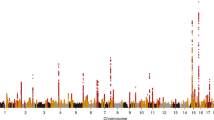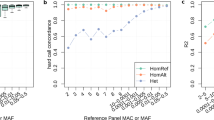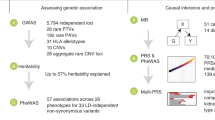Abstract
Chemokine (C–C motif) ligand 5 (CCL5) and chemokine (C–C motif) receptor 5 are implicated in the pathogenesis of diabetic nephropathy (DN). We hypothesize that variants in these genes may be associated with DN. The CCL5 and chemokine receptor type 5 (CCR5) genes were resequenced, variants identified (n=58), allele frequencies determined in 46 individuals (92 chromosomes) and efficient haplotype tag single-nucleotide polymorphisms (htSNPs) selected to effectively evaluate the common variation in these genes. One reportedly functional gene variant and eight htSNPs were genotyped in a case–control association study involving Caucasian individuals with type 1 diabetes (267 cases with DN and 442 non-nephropathic diabetic controls). Genotyping was performed using MassARRAY iPLEX, TaqMan, gel electrophoresis and direct capillary sequencing. After correction for multiple testing, there were no statistically significant associations between variants in the CCL5 and CCR5 genes and DN.
Similar content being viewed by others
Main
Diabetic nephropathy (DN) is the leading cause of end-stage renal disease in the Western world1 with significant evidence that a subset of type 1 diabetic patients are genetically predisposed to developing DN.2 Chemokine (C–C motif) ligand 5 (alternatively known as regulated upon activation, normal T cell expressed and secreted; CCL5) and its cognate receptor, chemokine receptor type 5 (CCR5), are biological candidate genes for DN.
CCL5 is a potent chemoattractant produced by renal mesangial cells, which is active in the recruitment of monocytes and macrophages into the glomeruli and interstitium. CCL5 is nuclear factor -κB dependent and is upregulated by proteinuria3 and other factors associated with the diabetic milieu.4, 5, 6 Blockade of CCR5 has been shown to substantially reduce monocyte infiltration in experimental glomerulonephritis.7 CCL5 and CCR5 have received considerable attention as candidate genes for DN, although these studies have focused on selected variants with inconsistent findings.8, 9, 10, 11, 12, 13, 14, 15
The CCL5 gene locus has been assigned to 17q11.2-q12,16 and the CCR5 gene is located on chromosome 3p21.17 Coding regions, intron–exon boundaries, untranslated and flanking regions of the CCL5 and CCR5 genes have been comprehensively screened to identify polymorphisms, and a robust case–control study was performed to assess the association between common haplotype tagging or functional variants and DN in a Caucasian population with type 1 diabetes.
The Irish case– control collection investigated in this paper has been described previously.18 Briefly, cases have type 1 diabetes with DN, while controls are type 1 diabetic patients without nephropathy. The average age at recruitment of cases and controls was 48.7 (s.d. 9.6) years and 42.2 (s.d. 11.7) years, respectively, with an average disease duration of 32.0 (s.d. 9.6) years for cases and 27.2 (s.d. 9.3) years for controls.
The CCL5 and CCR5 reference sequences (accession number chromosome:NCBI35:17:31217613:31236490:1 and chromosome:NCBI35:3:46381637:46396695:1, respectively) were obtained from the National Centre for Biotechnology Information (http://www.ncbi.nlm.nih.gov). Reference mRNA (CCL5, NM_002985, GI:22538813; CCR5, NM_000579, GI:4502638) sequences were used to determine exon–intron boundaries. Overlapping fragments (average length=674 bp) were PCR amplified using genomic DNA from 23 case and 23 control samples. Primers and PCR conditions are available from the authors. Bidirectional sequencing, screening for variants, haplotype tag single-nucleotide polymorphism (htSNP) selection and genotyping were performed as previously described.18
The resequenced data have been submitted to GenBank as (a) GQ504011 C–C chemokine ligand 5 (CCL5) gene, promoter region and complete cds, and as (b) GQ917109 C–C chemokine receptor type 5 (CCR5) gene and complete cds. Novel SNPs have been submitted to dbSNP (Table 1).
We screened almost 6 kb of the CCL5 gene, including all exons, exon–intron boundaries and untranslated regions. Our resequenced data established four differences compared with the GenBank reference sequence for CCL5 (c.−881G>A, c.−641A>G, c.−534delC and c.−518delA). In all 13 novel SNPs were identified, of which 11 had a minor allele frequency <5%. A total of 27 variants were identified in the screened regions of CCL5 (Table 1). Genotypes for 10 SNPs with an MAF >5% in 23 cases and 23 controls were used to estimate the haplotype frequencies (Supplementary Figure 1). Eight haplotypes were identified and three htSNPs genotyped using Sequenom MassARRAY iPLEX (Sequenom, San Diego, CA, USA) and direct capillary sequencing in our case–control collection.
In the approximately 9 kb of CCR5 screened, six novel SNPs were identified, five of which had an MAF <5%. Thirty-one variants were identified in total (Table 1), 22 of which were used to estimate the haplotype frequencies (Supplementary Figure 1). Haplotype frequencies were obtained from snphap and input into Stata, in which the htsearch command was used to identify htSNPs. Twelve haplotypes were observed and five htSNPs selected, including CCR5_rs333, a 32-bp deletion reported to confer resistance to HIV.19 One additional SNP (CCR5_rs1799987) was selected for genotyping on the basis of previous association with DN,8, 9, 10, 11, 12, 13 as well as putative functionality.19 The selected SNPs were genotyped in an Irish case–control collection of sufficient size to provide approximately 80% power to detect an odds ratio (OR) of 1.6, with an MAF of 10%. No SNP exhibited deviation from Hardy–Weinberg equilibrium (P>0.001). Our case–control collection was selected using strict phenotypic criteria and has been previously used to investigate association with DN.18, 20, 21
Greater than 95% completion was achieved for all genotyped SNPs. Contingency table χ2 tests were used to compare genotype and allele frequencies between cases and controls.
No CCL5 variants were found to be associated with DN (Table 2). The CCR5_rs7637813 AA genotype was more common in controls than in cases (50.5 vs 42.1%; P=0.04, Table 2). Haplotype analysis using Haploview18 revealed that the CCR5 haplotypes rs7637813A, rs10577983Ins, rs2227010A, rs333Ins and rs17765882T were also more common in the control group than in the case group (8.9 vs 5.8%; P=0.03, Supplementary Table 1). Adjustment for multiple comparisons using Bonferroni correction rendered these P-values non-significant.
The rationale behind this investigation is supported by both in vitro and in vivo studies, together with previous reports of association for DN. Investigations in Japanese and Asian Indian populations have suggested an association between CCR5_rs1799987 (alias 59029G>A) and DN and renal insufficiency in the type 2 diabetic population.8, 11, 12, 13 CCR5_rs1799987 is a putatively functional variant, located in the promoter region, which influences expression of the CCR5 protein.19 As CCR5_rs1799987 is the most frequently investigated SNP in previous publications, a sample size calculation was performed for this variant. Our case–control collection is of sufficient size to give approximately 80% power to detect as statistically significant (P<0.05) an OR of 1.4 for the A allele of CCR5 CCR5_rs1799987, and an OR of 1.6 for any locus of which the minor allele frequency exceeds 10%. Risk haplotypes of CCR5_rs1799987 and CCR5_rs333 have been associated with DN in Caucasian type 1 diabetic male patients only;10 this was not supported by our study (data not shown). Some other contradictory findings have also been reported.14, 15
The published association studies on CCL5 and CCR5 performed to date have focused on one or two selected variants in the gene, which were often chosen on the basis of function. A meta-analysis was performed to include data from these reports,8, 9, 10, 11, 12, 13, 14 which investigated three loci relevant to our study: CCL5_rs2107538 (pooled OR 0.99; 95% CI 0.80–1.23; P=0.94), CCR5_rs1799987 (pooled OR 0.96; 95% CI 0.78–1.17; P=0.66) and CCR5_rs333 (pooled OR 0.96; 95% CI 0.78–1.19; P=0.73). It should be noted that studies investigating CCR5_rs1799987 exhibit heterogeneity even after the exclusion of the data reported by Ahluwalia et al.,13 which showed very marked deviations from Hardy–Weinberg equilibrium. This suggests that, for this analysis, the results from the different studies were not consistent. Further details are available in Supplementary Figure 2. Collectively, no significant association has been revealed between these variants and DN.
The importance of screening for variants is highlighted by the identification of three novel variants in this study with MAF>10%, one of which was selected by Stata as an htSNP (Table 1). Furthermore, comparison with HapMap (http://hapmap.ncbi.nlm.nih.gov/ accessed 23 November 2009) revealed that genotype data were available for only 40% of the CCL5 variants and 6% of the CCR5 variants investigated in this study (Table 1). This reinforces the value of resequencing for a comprehensive study of all common variations in the CCR5 gene.
This study has investigated common CCL5 and CCR5 variants in the Irish type 1 diabetic population and did not reveal a statistically significant association with DN. Despite evidence of association between individually selected variants and DN in primarily Japanese and Indian type 2 diabetic populations, this could not be confirmed in our Caucasian type 1 diabetic collection. This may reflect the divergent genetic background of different ethnic and disease groups.
Our results indicate that common variants in CCL5 and CCR5 do not strongly influence genetic susceptibility to DN in Caucasian individuals with type 1 diabetes.
Accession codes
References
USRDS Coordinating Center. US Renal Data System Report 2009 2009. Available at: http://www.usrds.org/adr.htm. (accessed 3 November 2009).
Savage, D. A., Bain, S. C., McKnight, A. J. & Maxwell, A. P. Gene discovery in diabetic nephropathy. Curr. Diab. Rep. 7, 139–145 (2007).
Zoja, C., Donadelli, R., Colleoni, S., Figliuzzi, M., Bonazzola, S. & Morigi, M.,et al. Protein overload stimulates RANTES production by proximal tubular cells depending on NF-kappa B activation. Kidney Int. 53, 1608–1615 (1998).
Wolf, G., Aberle, S., Thaiss, F., Nelson, P. J., Krensky, A. M., Neilson, E. G. et al. TNF alpha induces expression of the chemoattractant cytokine RANTES in cultured mouse mesangial cells. Kidney Int. 44, 795–804 (1993).
Wolf, G., Ziyadeh, F. N., Thaiss, F., Tomaszewski, J., Caron, R. J., Wenzel, U. et al. Angiotensin II stimulates expression of the chemokine RANTES in rat glomerular endothelial cells. Role of the angiotensin type 2 receptor. J. Clin. Invest. 100, 1047–1058 (1997).
Deckers, J. G., Van Der Woude, F. J., Van Der Kooij, S. W. & Daha, M. R. Synergistic effect of IL-1alpha, IFN-gamma, and TNF-alpha on RANTES production by human renal tubular epithelial cells in vitro. J. Am. Soc. Nephrol. 9, 194–202 (1998).
Panzer, U., Schneider, A., Wilken, J., Thompson, D. A., Kent, S. B. & Stahl, R. A. The chemokine receptor antagonist AOP-RANTES reduces monocyte infiltration in experimental glomerulonephritis. Kidney Int. 56, 2107–2115 (1999).
Nakajima, K., Tanaka, Y., Nomiyama, T., Ogihara, T., Ikeda, F., Kanno, R. et al. RANTES promoter genotype is associated with diabetic nephropathy in type 2 diabetic subjects. Diabetes Care 26, 892–898 (2003).
Yang, B., Houlberg, K., Millward, A. & Demaine, A. Polymorphisms of chemokine and chemokine receptor genes in Type 1 diabetes mellitus and its complications. Cytokine 26, 114–121 (2004).
Mlynarski, W. M., Placha, G. P., Wolkow, P. P., Bochenski, J. P., Warram, J. H. & Krolewski, A. S. Risk of diabetic nephropathy in type 1 diabetes is associated with functional polymorphisms in RANTES receptor gene (CCR5): a sex-specific effect. Diabetes 54, 3331–3335 (2005).
Mokubo, A., Tanaka, Y., Nakajima, K., Watada, H., Hirose, T., Kawasumi, M. et al. Chemotactic cytokine receptor 5 (CCR5) gene promoter polymorphism (59029A/G) is associated with diabetic nephropathy in Japanese patients with type 2 diabetes: a 10-year longitudinal study. Diabetes Res. Clin. Pract. 73, 89–94 (2006).
Prasad, P., Tiwari, A. K., Kumar, K. M., Ammini, A. C., Gupta, A., Gupta, R. et al. Association of TGFbeta1, TNFalpha, CCR2 and CCR5 gene polymorphisms in type-2 diabetes and renal insufficiency among Asian Indians. BMC Med. Genet. 8, 20 (2007).
Ahluwalia, T. S., Khullar, M., Ahuja, M., Kohli, H. S., Bhansali, A., Mohan, V. et al. Common variants of inflammatory cytokine genes are associated with risk of nephropathy in type 2 diabetes among Asian Indians. PLoS One 4, e5168 (2009).
Joo, K. W., Hwang, Y. H., Kim, J. H., Oh, K. H., Kim, H., Shin, H. D. et al. MCP-1 and RANTES polymorphisms in Korean diabetic end-stage renal disease. J. Korean Med. Sci. 22, 611–615 (2007).
Ewens, K. G., George, R. A., Sharma, K., Ziyadeh, F. N. & Spielman, R. S. Assessment of 115 candidate genes for diabetic nephropathy by transmission/disequilibrium test. Diabetes 54, 3305–3318 (2005).
Donlon, T. A., Krensky, A. M., Wallace, M. R., Collins, F. S., Lovett, M. & Clayberger, C. Localization of a human T-cell-specific gene, RANTES (D17S136E), to chromosome 17q11.2-q12. Genomics 6, 548–553 (1990).
Gao, J. L., Kuhns, D. B., Tiffany, H. L., McDermott, D., Li, X., Francke, U. et al. Structure and functional expression of the human macrophage inflammatory protein 1 alpha/RANTES receptor. J. Exp. Med. 177, 1421–1427 (1993).
McKnight, A. J., Woodman, A. M., Parkkonen, M., Patterson, C. C., Savage, D. A., Forsblom, C. et al. Investigation of DNA polymorphisms in SMAD genes for genetic predisposition to diabetic nephropathy in patients with type 1 diabetes mellitus. Diabetologia 52, 844–899 (2009).
McDermott, D. H., Zimmerman, P. A., Guignard, F., Kleeberger, C. A., Leitman, S. F. & Murphy, P. M. CCR5 promoter polymorphism and HIV-1 disease progression. Multicenter AIDS Cohort Study (MACS). Lancet 352, 866–870 (1998).
McKnight, A. J., Maxwell, A. P., Patterson, C. C., Brady, H. R. & Savage, D. A. Association of VEGF -1499C → T polymorphism with diabetic nephropathy in type 1 diabetes mellitus. J. Diabetes Complications 21, 242–245 (2007).
Pettigrew, K. A., McKnight, A. J., Martin, R. J., Patterson, C. C., Kilner, J., Sadlier, D. et al. No support for association of protein kinase C, beta 1 (PRKCB1) gene promoter polymorphisms c.-1504C>T and c.-546C>G with diabetic nephropathy in Type 1 diabetes. Diabet. Med. 25, 1127–1129 (2008).
Acknowledgements
This work was funded by the Northern Ireland Kidney Research Fund. KAP was supported by a PhD studentship from the Department of Employment and Learning.
Author information
Authors and Affiliations
Corresponding author
Ethics declarations
Competing interests
The authors declare no conflict of interest.
Additional information
Supplementary Information accompanies the paper on Journal of Human Genetics website
Rights and permissions
About this article
Cite this article
Pettigrew, K., McKnight, A., Patterson, C. et al. Resequencing of the CCL5 and CCR5 genes and investigation of variants for association with diabetic nephropathy. J Hum Genet 55, 248–251 (2010). https://doi.org/10.1038/jhg.2010.15
Received:
Revised:
Accepted:
Published:
Issue Date:
DOI: https://doi.org/10.1038/jhg.2010.15



